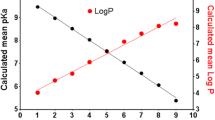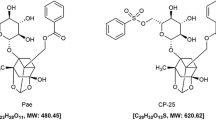Abstract
The toxicokinetics of pentachlorophenol (PCP) were studied in B6C3F1 mice, a strain in which PCP was previously found to be carcinogenic. In a crossover design, doses of 15 mg/kg were given intravenously (bolus) and orally (gastric intubation) to six animals. Concentrations of PCP in blood, urine, and feces were measured by capillary gas chromatography with electron-capture detection. After intravenous administration, the values of clearance and volume of distribution were 0.057 ± 0.007 L/hr/kg and 0.43 ± 0.06 L/kg, respectively. These two parameters exhibited low intermouse variability (coefficients of variation <14%). The elimination half-life was 5.2 ± 0.6 hr. After oral administration, the PCP peak plasma concentration (28 ± 7 µg/ml) occurred at 1.5 ± 0.5 hr and absorption was complete (bioavailability = 1.06 ± 0.09). The elimination half-life was 5.8 ± 0.6 hr. Only 8% of the PCP dose was excreted unchanged by the kidney. PCP was primarily recovered in urine as conjugates. A portion of the dose was recovered in urine as the mutagen, tetrachlorohydroquinone (5%) (TCHQ), and its conjugates (15%). For both PCP and TCHQ, sulfates accounted for 90% or more of the total conjugates (glucuronides and sulfates).
Similar content being viewed by others
REFERENCES
F. J. Mycroft and R. Schlag. Pentachlorophenol (PCP). Hazard Rev. 3:1–3 (1986).
Anonymous. Pentachlorophenol, Environmental Health Criteria 71, World Health Organization (WHO), Geneva, 1987.
R. H. Hill, T. Teresa, J. S. Holler, M. F. Douglas, S. J. Smith, L. L. Needham, and S. Binder. Residues of chlorinated phenols and phenoxy acid herbicides in the urine of Arkansas children. Arch. Environ. Contam. Toxicol. 18:469–474 (1989).
H. A. Hattemer-Frey and C. C. Travis. Pentachlorophenol: Environmental partitioning and human exposure. Arch. Environ. Contam. Toxicol. 18:482–489 (1989).
E. C. Weinbach. The effect of pentachlorophenol on oxidative phosphorylation. J. Biol. Chem. 210:300–315 (1954).
B. A. Schwetz, P. A. Keepler, and P. J. Gehring. The effect of purified and commercial grade pentachlorophenol on rat embryonal and fetal development. Toxicol. Appl. Pharmacol. 28:151–161 (1974).
E. E. McConnel. Toxicology and carcinogenesis studies of two pentachlorophenol technical-grade mixtures in B6C3F1 mice. U.S. National Toxicology Program. Department of Health and Human Services, NIH Publication No. 89-2804, 1989.
F. Y. Bois, L. Zeise, and T. N. Tozer. The use of pharmacokinetic models in the determination of risks for regulatory purposes. In J. J. Bonin and D. E. Stevenson (eds.), Risk Assessment in Setting National Priorities, Plenum Press, New York, 1989, pp. 573–583.
L. Zeise, R. Wilson, and E. A. C. Crouch. Dose-response relationships for carcinogens: A review. Environ. Health Perspect. 73:259–308 (1987).
M. W. Anderson, D. G. Hoel, and N. L. Kaplan. A general scheme for the incorporation of pharmacokinetics in low-dose risk estimation for chemical carcinogenesis: Example-vinyl chloride. Toxicol. Appl. Pharmacol. 55:154–161 (1980).
V. J. Cogliano, S. Irene, R. Rubenstein, D. V. Singh, S. Segal, and B. Allen. Issues surrounding the quantitative cancer risk assessment of pentachlorophenol. Toxicologist 11:71 (1991).
U. G. Ahlborg, J. E. Lindgren, and M. Mercier. Metabolism of pentachlorophenol. Arch. Toxicol. 32:271–281 (1974).
I. Jakobson and S. Yllner. Metabolism of 14C-pentachlorophenol in the mouse. Acta Pharmacol. Toxicol. 29:513–524 (1971).
I. Witte, U. Juhl, and W. Butte. DNA-damaging properties and cytotoxicity in human fibroblasts of tetrachlorohydroquinone, a pentachlorophenol metabolite. Mutat. Res. 145:71–75 (1985).
G. Renner, C. Hopfer, and J. M. Gokel. Acute toxicities of pentachlorophenol, pentachloroanisole, tetrachlorohydroquinone, tetrachlorocatechol, tetrachlororesorcinol, tetrachlorodimethoxybenzenes and tetrachlorobenzenediol diacetates administered to mice. Toxicol. Environ. Chem. 11:37–50 (1986).
B. G. Reigner, J. F. Rigod, and T. N. Tozer. Simultaneous assay of pentachlorophenol and its metabolite, tetrachlorohydroquinone, by gas chromatography without derivatization. J. Chromatogr. 533:111–124 (1990).
J. Tomasic. Analysis of glucuronic acid conjugates. In E. R. Garret and J. L. Hirtz (eds.), Drug Fate and Metabolism, Vol. 2, Marcel Dekker, New York, 1978, pp. 282–335.
T. Ohshima, I. Johno, and S. Kitazawa. Comparative evaluation of microultrafiltration devices for determination of protein binding. Ther. Drug Monit. 10:310–315 (1988).
H. J. Hoben, S. A. Ching, R. A. Young, and L. J. Casarett. A study of the inhalation of pentachlorophenol by rats. V. Protein binding study of pentachlorophenol. Bull. Environ. Contam. Toxicol. 16:225–232 (1976).
T. N. Tozer. Implications of altered plasma protein binding in disease state. In L. Z. Benet et al. (eds.), Pharmacokinetic Basis of Drug Treatment, Raven Press, New York, 1984, pp. 173–193.
S. Øie and J. Huang. Binding: Should free drug levels be measured: In D. D. Breimer and P. Speiser (eds.), Topics in Pharmaceutical Sciences, Elsevier Science, New York, 1983, pp. 51–62.
B. Sebille, R. Zini, C. Madjar, N. Thuaud, and J.-P. Tillement, Separation procedures used to reveal and follow drug-protein binding. J. Chromatogr. 531:51–77 (1990).
J. H. N. Meerman, M. J. Sterenborg, and G. J. Mulder. Use of pentachlorophenol as long-term inhibitor of sulfation of phenols and hydroxamic acids in the rat in vivo. Biochem. Pharmacol. 32:1587–1593 (1983).
B. G. Reigner, R. A. Gungon, M. K. Hoag, and T. N. Tozer. Pentachlorophenol toxicokinetics after intravenous and oral administration to rat. Xenobiotica 21:1547–1558 (1991).
H. M. Kaplan, N. R. Brewer, and W. H. Blair. Physiology. In H. L. Foster, J. D. Small, and J. G. Fox (eds.), The Mouse in Biomedical Research, Academic Press, New York, 1983, pp. 247–292.
H. Boxenbaum. Interspecies variation in liver weight, hepatic blood flow, and antipyrine intrinsic clearance: Extrapolation of data to benzodiazepines and phenytoin. J. Pharmacokinet. Biopharm. 8:165–176 (1980).
M. Rowland and T. N. Tozer. Clinical Pharmacokinetics, Concepts and Applications, 2nd ed., Lea & Febiger, Philadelphia, 1989.
M. Gibaldi. Biopharmaceutics and Clinical Pharmacokinetics, Lea & Febiger, Philadelphia, 1991.
Author information
Authors and Affiliations
Rights and permissions
About this article
Cite this article
Reigner, B.G., Rigod, J.F. & Tozer, T.N. Disposition, Bioavailability, and Serum Protein Binding of Pentachlorophenol in the B6C3F1 Mouse. Pharm Res 9, 1053–1057 (1992). https://doi.org/10.1023/A:1015810629245
Issue Date:
DOI: https://doi.org/10.1023/A:1015810629245




